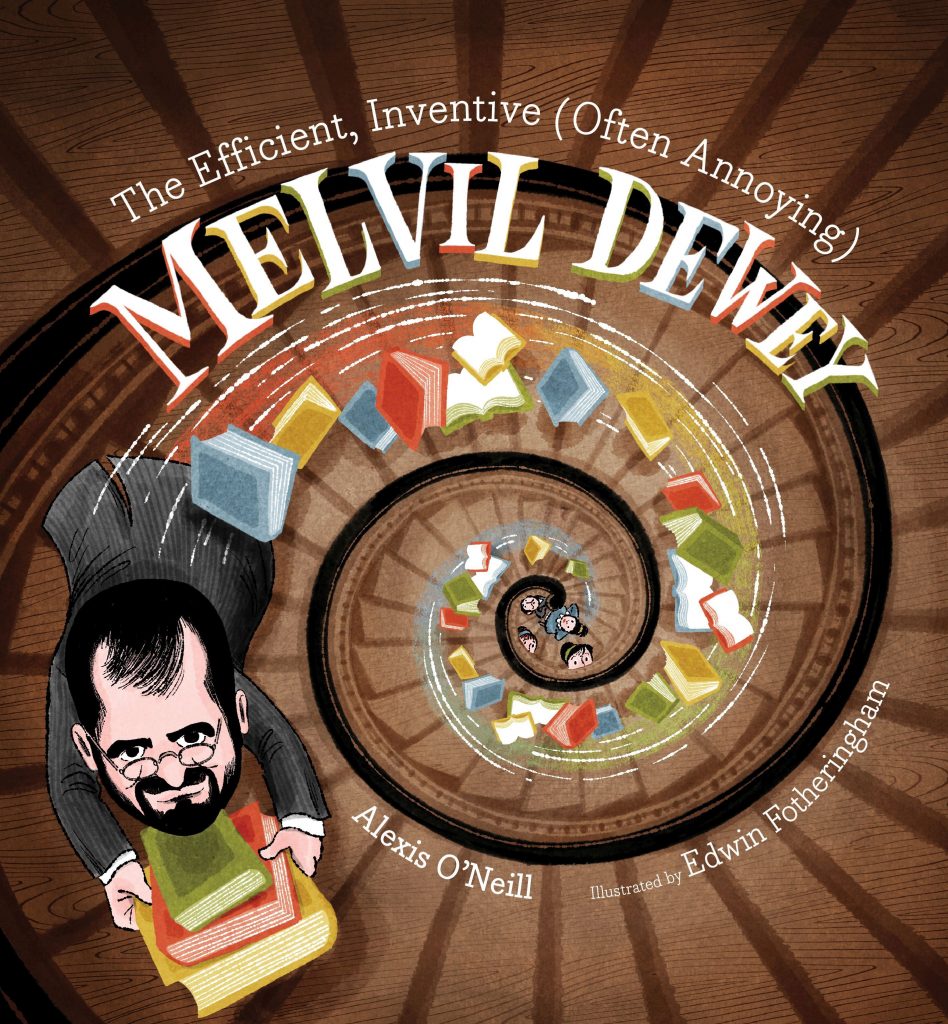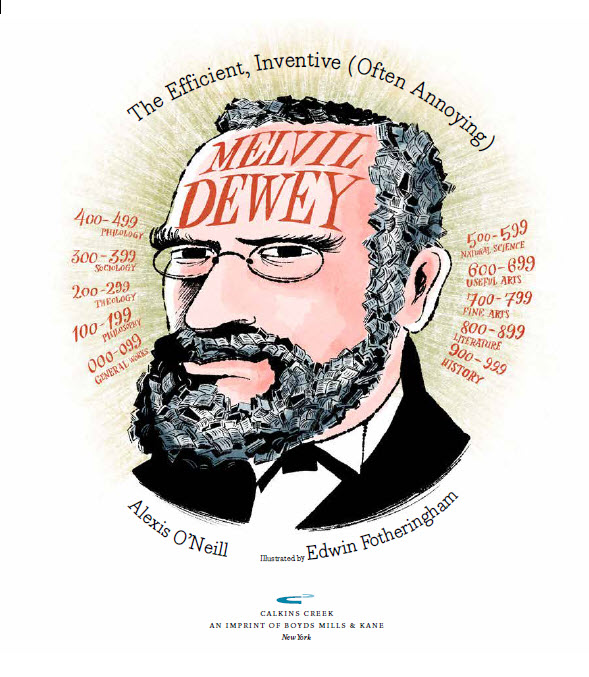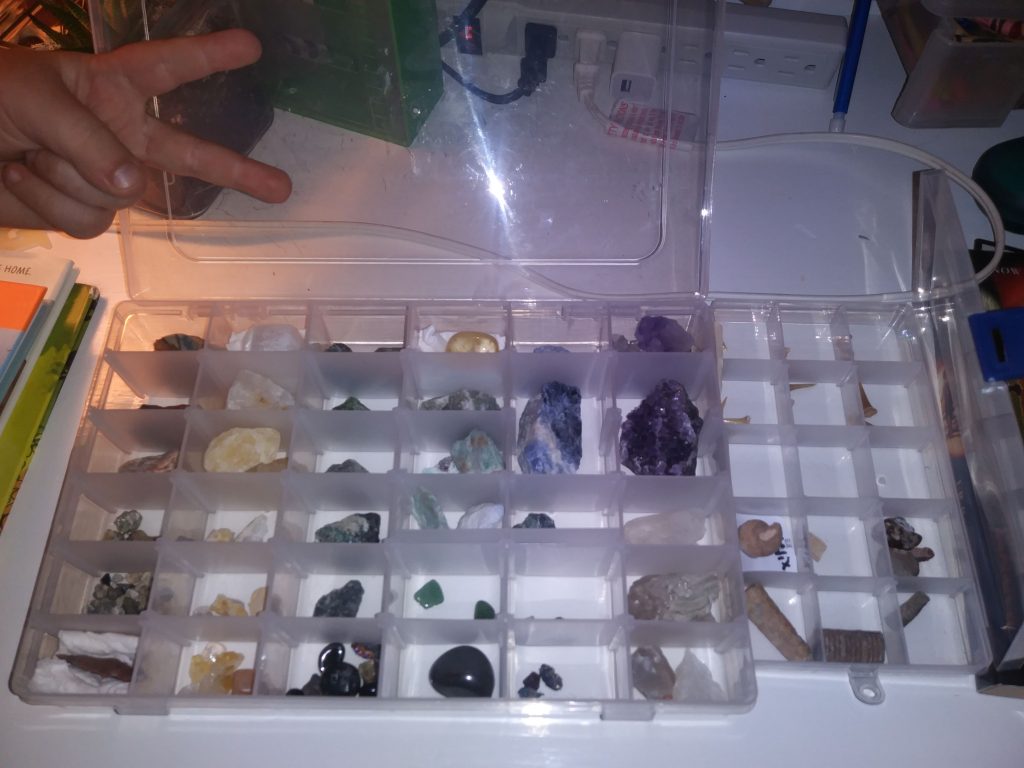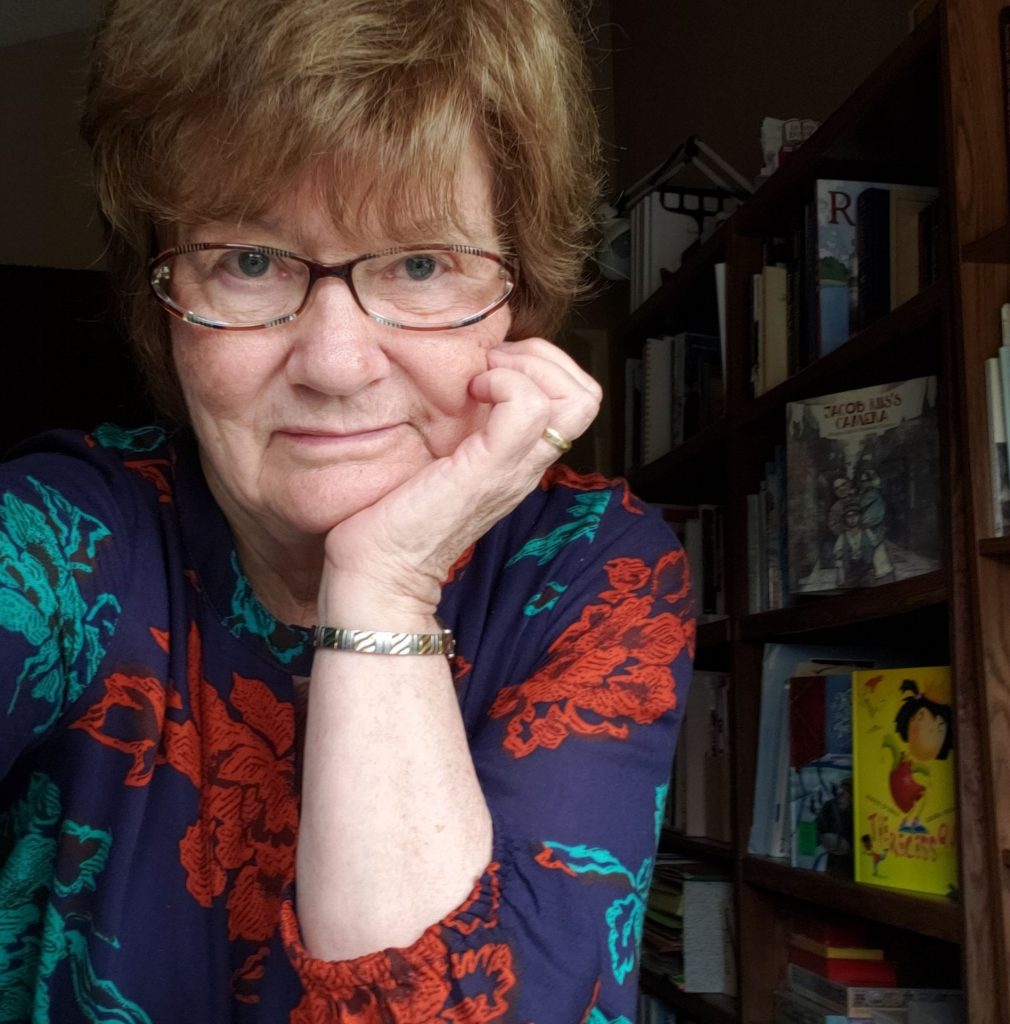
GUEST BLOGGER ALEXIS O’NEILL

Melvil Dewey, a complicated, driven, creative person, is the subject of my newest picture book biography, The Efficient, Inventive (Often Annoying) Melvil Dewey with lively illustrations by Edwin Fotheringham. Dewey’s love of organization and words at a very early age drove him to develop and implement his library Dewey Decimal Classification system, found a school to train librarians, and create inventions to streamline librarians’ work. His contributions left a significant and lasting impact on libraries throughout the world.
Different library, different system
Mathematics helps us solve many kinds of problems. And Melvil Dewey used his knowledge of mathematics to solve a very big problem for library users.
Before Dewey, every library had its own system for arranging books. Some libraries arranged books on shelves by height, some by the color of the cover, and some books were even stacked in a pile on the floor. As a result, trying to find the exact book you were looking for was frustrating. And each time you went to a different library, you’d have to learn a whole new system!
Eureka! – A uniform system for every library
Dewey challenged himself to create a uniform way to organize books that could be used in every library because he wanted readers to be able to find the books they wanted quickly. His “Eureka” moment came when he came up with the idea to use a system of numbers and decimals which would be visible on the spines of informational books. These books would be arranged in numerical order on the shelves. (Fiction would be arranged by the author’s last name in another area of the library.)

He classified knowledge into ten classes, represented by a number in the “hundreds” place.) He then divided each class into ten subdivisions of that knowledge, represented bya number in the “tens” place. Then each subdivision was divided into ten subsections of the subdivisions (a number in the “ones” place.) Finally, after the decimal point, a specific book is identified with additional numbers.
For example, if you wanted to find an elephant in the library (or at least, a book about elephants!), here’s what the label would mean:
- Science = 500 (First number = main class of world knowledge)
- Animals = 590 (Second number = a subdivision of knowledge)
- Mammals = 599 (Third number = a subsection of a subdivision of knowledge)
- Elephants = 599.6 (After the decimal = a specific degree of classification of the subsection of a subdivision of knowledge)
Once you know the ten general classifications, you can find your favorite section of nonfiction in any library using the Dewey Decimal Classification system (DDC). Over 200,000 libraries in 135 countries use it.
| Dewey Decimal Classification System (DDC) — The Ten Main Classes | |
|---|---|
| 000 | Computer science, information, & general works |
| 100 | Philosophy & psychology |
| 200 | Religion |
| 300 | Social sciences |
| 400 | Language |
| 500 | Science |
| 600 | Technology |
| 700 | Arts & recreation |
| 800 | Literature |
| 900 | History & geogrpahy |
What’s your system?
Ask your students if they have a special collection of objects. Maybe they collect sports cards, stickers, buttons, pencils, dolls, stuffed animals, books, shells, or stones.
- Then have them write about it! When did they start their collection? Why did they decide to collect this particular kind of object? Have them describe any special way that they organize it: size? shape? color? something else?
- Suggest that your students apply a numbering system for their collection, and then have them explain it.
- Ask students to interview other family members or friends about objects they collect now, or used to collect.
- Have students draw a picture of one of their collections or draw a “family portrait” depicting all their family members, what they collect, and how they organize their collections.

Next, randomly divide the class into a “collection” of two groups.
- Call out a category – such as height, first name, birth month (which can be done numerically or alphabetically) – and have the students organize themselves in that order.
- The first to finish gets a point.
- Hand out cards with random Dewey numbers on them and have them repeat the process.
How can you make life easier like Dewey?
Dewey applied his Decimal Classification system first to the Amherst College library when he was an assistant librarian in 1875, then at Columbia College (now University). His inventiveness didn’t stop with the Decimal System. He also created a school to train librarians, double-sided editing pencils, rubber wheels on library carts, a hanging vertical file, and more to help with education and efficiency.
- Invite your students to invent something to make life easier for either an animal or a person. Suggest that they make a collage, painting, or drawing of their invention.
- Then for an engineering design challenge, have them make a 3-D prototype of it.
Decimals + Dewey = Creative spin-offs
Starting with his life-long obsession with the decimal system (he loved the beauty of counting by tens), Dewey applied his love of math (resulting in the DDC) and measurement (time efficiency) for the purpose of helping everyone have easier access to an education through books found in libraries.

Alexis O’Neill’s latest picture book biography is The Efficient, Inventive (Often Annoying) Melvil Dewey (Calkins Creek). She is also the author of fiction and nonfiction pictures books including The Recess Queen (Scholastic Press); The Kite That Bridged Two Nations: Homan Walsh and the First Niagara Suspension Bridge (Calkins Creek); and Jacob Riis’s Camera: Bringing Light to Tenement Children (Calkins Creek). Alexis is the recipient of the California Reading Association’s Dr. Marcus Foster Memorial Award because of her significant and outstanding contributions to reading throughout California and is an instructor for the UCLA Extension Writers’ Program. Website: www.alexisoneill.com Twitter: @AlexisInCA Instagram: @AlexisInCA17
Featured image credit: “Library Book Baskets” by Enokson is licensed under CC BY-NC 2.0







Leave a Reply
Your email is safe with me.